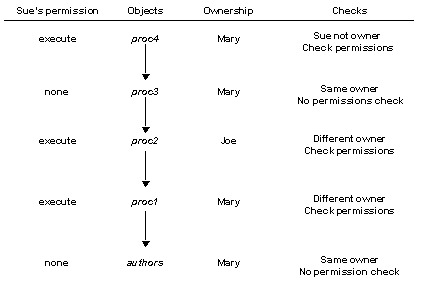Procedures follow the same rules as views. For example, suppose the ownership chain looks like this:
Figure 12-4: Ownership chains and permission checking for stored procedures

To execute proc4, Sue must have permission to execute proc4, proc2, and proc1. Permission to execute proc3 is not necessary because proc3 and proc4 have the same owner.
Adaptive Server checks Sue’s permissions on proc4 and all objects it references each time she executes proc4. Adaptive Server knows which referenced objects to check: it determined this the first time Sue executed proc4, and it saved the information with the procedure’s execution plan. Unless one of the objects referenced by the procedure is dropped or redefined, Adaptive Server does not change its initial decision about which objects to check.
This protection hierarchy allows every object’s owner to fully control access to the object. Owners can control access to views and stored procedures, as well as to tables.